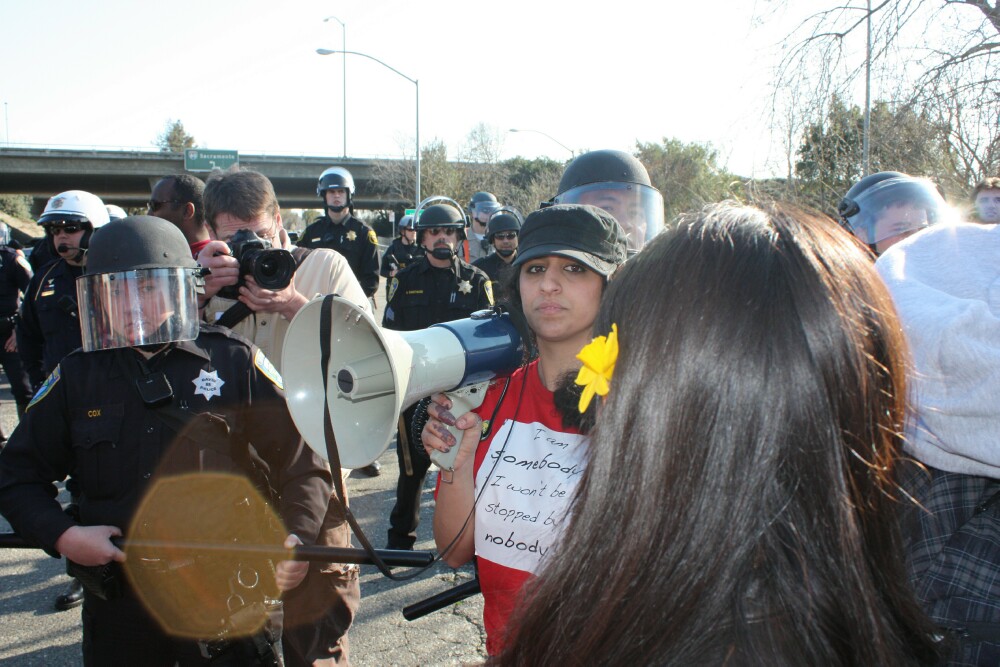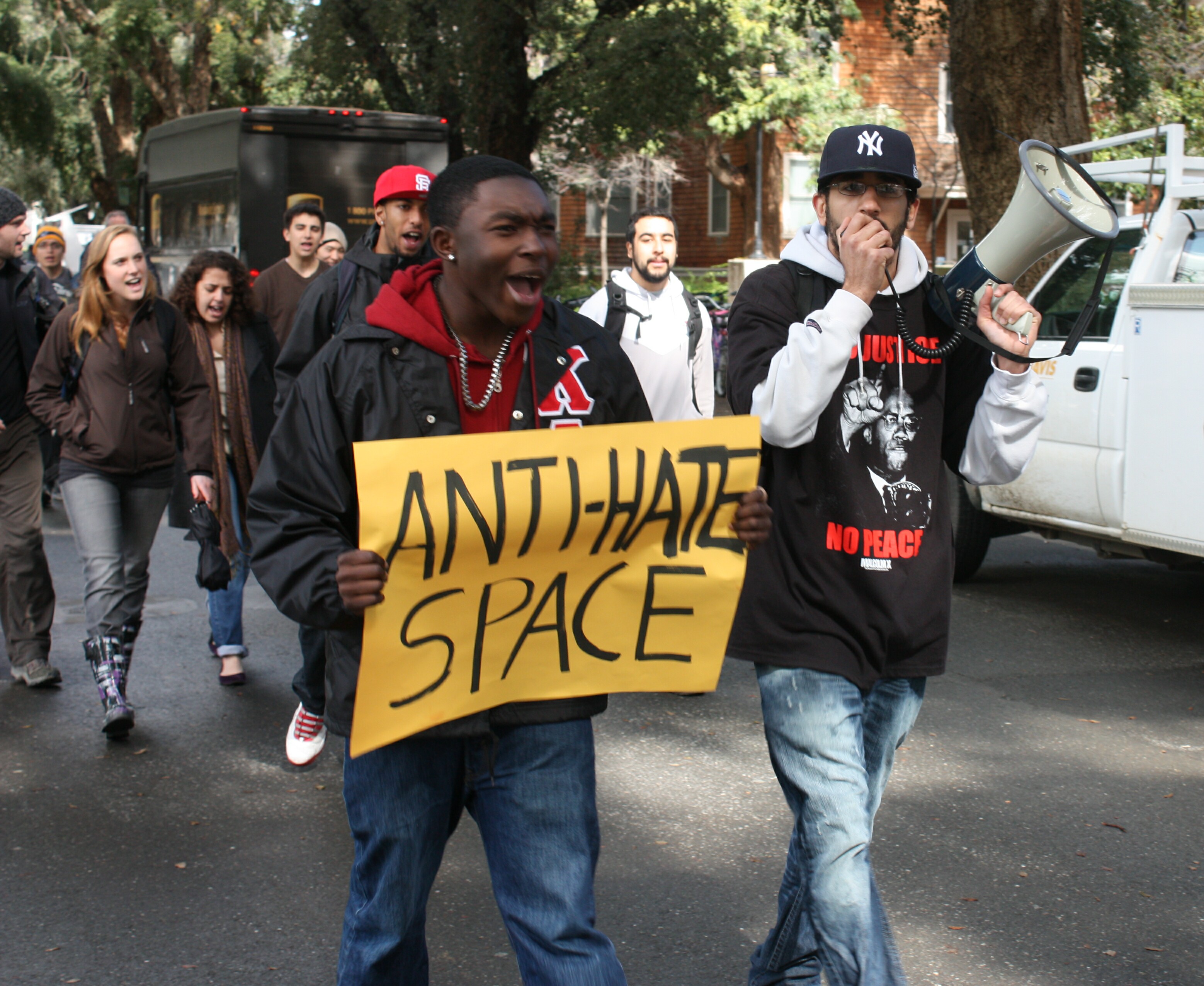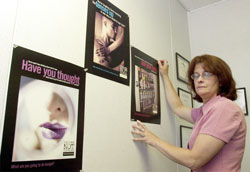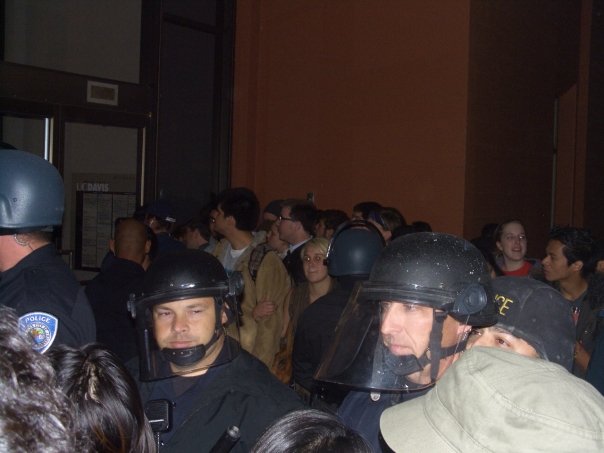Inside the Confrontation with Police At UC Davis

The Vanguard spoke with two of the protesters who were up on the front lines of the confrontation. The confrontation took place right before the freeway on-ramp just past the Mondavi center.

The Vanguard spoke with two of the protesters who were up on the front lines of the confrontation. The confrontation took place right before the freeway on-ramp just past the Mondavi center.

They were halted by hundreds of law enforcement officers in riot geer. At one point, pellet guns were fired and batons used in an effort to stop the students.

Statewide there have been a slew of incidents coinciding with heavy cuts and fee hikes to the UC. On Wednesday, a small but determined group, whose numbers were depleted by the threat of rain, met at the Memorial Union and marched to Mrak Hall.

An incident where vandalism was discovered on the campus building that houses the Lesbian, Gay, Bisexual, Transgender Resource Center will also be investigated as a hate crime.
 Dear UC Davis Faculty Members:
Dear UC Davis Faculty Members:
On September 24th we began the year by walking out of our classes and work- places in solidarity: students, faculty, workers, and staff who faced furloughs, lay- offs, pay cuts and tuition hikes, all left their buildings, classes and jobs to rally and march together against the privatization of education.
Workers and students showed overwhelming support for faculty grievances that day. We called attention to the lack of budget transparency and to faculty issues around self-governance. When administration claimed the Sept 24th walkout was led chiefly by faculty concerns, we refused to let that claim stand. We insisted we shared one struggle, and wouldn’t be divided by departments, titles, age or salary. We called ourselves equals—and took the future of our education, workplace, and university into our own hands. But since the walkout, the faculty voice has been almost entirely absent from the opposition to student fee increases and worker layoffs.
 A Joint Legislative Audit Committee voted 10-0 this week to have the state auditor examine the University of California’s financial practices following complaints and questions by many asking why student fees have gone up consistently while at the same time UC Executives have received lucrative raises and bonuses.
A Joint Legislative Audit Committee voted 10-0 this week to have the state auditor examine the University of California’s financial practices following complaints and questions by many asking why student fees have gone up consistently while at the same time UC Executives have received lucrative raises and bonuses.
Among the requests of the state auditor will be to: identify the sources of UC’s public funding; review and evaluate the policies and practices UC uses to track and allocate public funds; determine how the UC has spent its state appropriation, student fees, and funds from the federal government; evaluate UC’s practices for non-salary expenditures including travel, consultants, and entertainment; assess expenditures for instruction and identify the average amount per student UC spends on instruction; determine what funds are restricted and how; and examine auxiliary organizations, including expenditures.
 On Thursday, UC’s Board of Regents approved roughly 3.1 million dollars in incentive to 38 senior medical executives for meeting their 2009 performance goals. The payouts would range from 30,000 to 220,000 dollars in bonuses. The move comes six months after top executives received a 25 percent pay hike.
On Thursday, UC’s Board of Regents approved roughly 3.1 million dollars in incentive to 38 senior medical executives for meeting their 2009 performance goals. The payouts would range from 30,000 to 220,000 dollars in bonuses. The move comes six months after top executives received a 25 percent pay hike.
Amazingly according to multiple reports the incentive was simply the reduction of infection in hospitals which triggers tens of thousands if not hundreds of thousands in bonus pay. According to a release:
 I read Dave Taormino’s Op-Ed in the Enterprise today and he raises some interesting points against UC Davis constructing West Village, but also some faulty ones. But in the end, it was a bit unsettling to me that a developer would be arguing against someone else’s development. The first question that comes to my mind is that this is an inherent conflict of interest. At the very least it is a bit disingenuous.
I read Dave Taormino’s Op-Ed in the Enterprise today and he raises some interesting points against UC Davis constructing West Village, but also some faulty ones. But in the end, it was a bit unsettling to me that a developer would be arguing against someone else’s development. The first question that comes to my mind is that this is an inherent conflict of interest. At the very least it is a bit disingenuous.
Let me backtrack, recently Mr. Taormino presented before council his own development plan in Willowback. It’s a small development but drew a lot of complaints from the neighbors and at some point it will come back up. Giving the housing market right now and the expressed sentiments of the voters, I have to question the appropriateness of the timing of that proposal.
 But No One is Asking Where the Oversight Was –
But No One is Asking Where the Oversight Was – Both the Davis Enterprise and the Sacramento Bee have been on this aspect of the investigation. On Thursday, the Davis Enterprise reported on a UC Davis police investigation, laid out in a three-page probable cause statement that led to a search warrant in early December.

He offers specific reference to UC Davis in his comments dated December 2009, the irony is that unlike the past, I think the UC Davis officials and administrators fared fairly well. The situation that occurred was tense, it was perhaps dragged out too long as the students occupied Mrak Hall, but unlike the past, the university comes across of sympathetic and reasonable. Had they followed Dr. Garland’s advice, the situation would likely have escalated rather than de-escalated.
 While all of the newspaper headlines presented the gleeful headline, “No Charges Against UC Davis Protests.” The subtext of that release from District Attorney Jeff Reisig is much more subdued, “DA will monitor future demonstrations.”
While all of the newspaper headlines presented the gleeful headline, “No Charges Against UC Davis Protests.” The subtext of that release from District Attorney Jeff Reisig is much more subdued, “DA will monitor future demonstrations.”
UC Davis announced right before Thanksgiving last week that an agreement was reached whereby the protesters would end their occupation of Mrak which was done peacefully and without incident.
 With the University of California imposing a 32% fee increase to students and implementing furloughs and layoffs as a means to cut costs, the UC System is now under increased scrutiny from a variety of fronts. On November 23, 2009, the California Public Employment Relations Board (PERB) issued a complaint regarding unfair labor practices and bad faith negotiations.
With the University of California imposing a 32% fee increase to students and implementing furloughs and layoffs as a means to cut costs, the UC System is now under increased scrutiny from a variety of fronts. On November 23, 2009, the California Public Employment Relations Board (PERB) issued a complaint regarding unfair labor practices and bad faith negotiations.
This week, UC Associate Vice President for Information Resources and Communications, David Ernst was exposed for for misusing $150,000 in public moneys to finance lavish overseas trips, meals, and stays at expensive resorts under the guise of official business while he was employed at the California State University.

The caption reads, “this is what democracy looks like,” and across the state, the story is the same, students protesting, barricading, and getting arrested. For those who worried about the future leadership of this nation, worry not, this generation is just as capable as your own of battling authority.

Kristin Koster spoke to the Vanguard from the county jail, although she was not arrested.

After trying to hold an organized meeting on the steps we realized it was too loud to conduct business so we took an hour recess. After speaking with some of the organizers we were ushered to the front of the protest and the President of the Associated Students gave a brief speech.

Senator Yee:
“It is deeply disappointing that the Governor wants to ensure top executives live high on the hog while students suffer. The Governor’s veto is a slap in the face to all UC and CSU students and the system’s low wage workers. His veto protects the UC and CSU administration’s egregious executive compensation practices and allows them to continue to act more like AIG than a public trust.”

Certainly, the housing market collapse and the ensuing recession have led the State to the brink of a $26 billion financial abyss. At the brink, legislators have fractiously cobbled a budget that meets a 2/3 majority approval and sustains initiative designated expenditures. The budget reduces by 25% the 2008 allocation ($3.3 billion), which represents 17% of the total $19 billion budget. Student fees ($1.6 billion), medical center activity ($6.1 billion), and research grants ($2.7 billion) comprise the other major revenues.
 In February of 2007, the Sacramento Bee ran a story on reporting of sexual assaults, lauding UC Davis which at one point in time was criticized for underreporting sexual assaults, and then was “leading the way” in the reporting of crime.
In February of 2007, the Sacramento Bee ran a story on reporting of sexual assaults, lauding UC Davis which at one point in time was criticized for underreporting sexual assaults, and then was “leading the way” in the reporting of crime.
Wrote the Bee on February 16, 2007:

Organizers and speakers alike pointed to the fact that this was an extraordinary collaboration between students, faculty and staff that in many ways was unprecedented. All groups seemed very alarmed at the prospect for fee hikes which will make the university unaffordable and inaccessible to many segments of the population.
 Doctoral Candidate and former UC Davis (UCD) nurse researcher Janet Keyzer has filed a lawsuit against the Regents of the University of California, alleging that she and her husband were terminated from their employment at UC Davis after Ms. Keyzer reported research violations.
Doctoral Candidate and former UC Davis (UCD) nurse researcher Janet Keyzer has filed a lawsuit against the Regents of the University of California, alleging that she and her husband were terminated from their employment at UC Davis after Ms. Keyzer reported research violations.
According to the suit filed on September 18, Ms. Keyzer began working within the Community Oriented Pain Management Exchange (COPE) in April 2006, which was created to evaluate pain diagnosis and treatment at California State Prisons. It was a federally-funded collaborative effort between UCD, the California Department of Corrections (CDC), and the Correctional Medicine Network at UC San Francisco (UCSF).